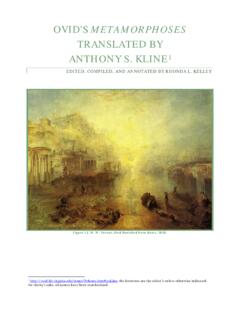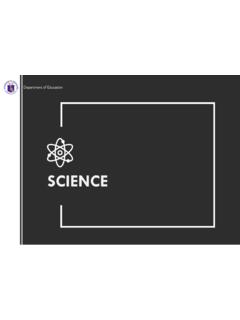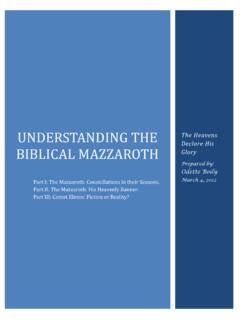Transcription of Earth Science Regents Review #2
1 K. Coder 2015 Kaitlin Coder 2015 Earth Science Regents Review #2 Astronomy Topics Reviewed: Organization of the Universe Origin of the Universe Galaxies & Stars Solar System Orbits The Moon Earth s Motions Seasonal Changes & Path of the Sun PLUS 39 Practice Regents Questions with Answers! K. Coder 2015 Regents Review #2 ASTRONOMY 7) ORGANIZATION OF THE UNIVERSE Largest ---------------------------------------- ---------------------------------------- ----------> Smallest Universe, Galaxy, Solar System, Sun, Planet, Moons/Asteroids/Meteoroids/Comets 8) UNIVERSE a) The universe began with a big explosion--"The Big Bang" billion years ago. b) Evidence of the big bang: i) Cosmic microwave background radiation ii) Red shift of light from distant galaxies (indicates galaxies are moving away & universe is expanding) 9) GALAXIES AND STARS a) Galaxies are groups of hundreds of billions of stars.
2 B) Our solar system is located on one of the outer arms of our spiral Milky Way Galaxy. c) Our Sun and all stars produce light energy by nuclear fusion of hydrogen. d) All stars have life cycles (see ESRT ). Our sun is a main sequence star . e) All stars are classified based upon their size/luminosity and temperature/color. (see ESRT ) Our sun is average sized and average temperature (yellow color). 10) SOLAR SYSTEM a) Our solar system (sun, planets, asteroids, comets, meteors) formed billion years ago when a cloud of gas and dust was pulled together due to gravity. b) Terrestrial planets (inner four) are rocky and small. Jovian planets (outer four) are gaseous and large. See ESRT for planetary data. c) Venus is the hottest planet in our solar system due to the runaway greenhouse effect. Venus atmosphere is 95% carbon dioxide (greenhouse gas) which allows light to pass through, but traps heat near the surface.
3 11) ORBITS a) Planets revolve around the Sun in an elliptical orbit with the sun at one focus. b) Aphelion: the point on an orbit farthest from the sun (July). c) Perihelion: the point on an orbit closest to the sun (January). d) Eccentricity can be calculated (ESRT for equation). The closer the value is to 1, the more elliptical the orbit. e) Eccentricity data form planets in our solar system can be found on ESRT page 15. f) The closer a planet is to the sun, the greater its gravitational attraction, the greater its orbital velocity (the faster it orbits), and the shorter its period of revolution. K. Coder 2015 12) THE MOON a) Phases & Motions of the Moon i) Moon phases are cyclic and predictable. ii) We only see the same side of the moon because the Moon s period of rotation ( days) equals the Moon s period of revolution around Earth ( days). (ESRT p. 15) iii) Moon phases are caused by the Moon s revolution of Earth .
4 We see a full cycle of Moon phases every days. iv) Know how to determine Moon phase as seen from Earth using a diagram of the Moon s orbit: b) Ocean Tides i) Tides are the cyclic & predictable rise and fall of ocean waters. (1) Tides are caused by the gravitational pull of the Sun and the Moon. (2) The Moon has more influence over the tides because it is closer to Earth . ii) Time from high tide to high tide (or low tide to low tide) = 12 hours 26 minutes iii) Spring tides: Extreme tidal change (highest high tides/lowest low tides) = Full or New Moon iv) Neap tides: Minimal tidal change (lowest high tides/highest low tides) = 1st or 3rd Quarter Moon c) Eclipses i) Solar eclipse: Sun is blocked by the Moon. Only occurs during New Moon. ii) Lunar eclipse: Moon moves into Earth s shadow. Only occurs during Full Moon. iii) Eclipses are rare because the Moon orbits Earth on a 5 incline. Steps to determine the Phase of the Moon: an arrow from the observer to the selected position.
5 Your paper so that the arrow is pointed directly away from you. the far half of the moon. the amount of light and dark you see on the same side as you view it. K. Coder 2015 13) Earth S MOTIONS a) Earth Rotates on axis DAILY. Evidence: i) All celestial objects appear to rise in the east and move west. (apparent motion) ii) Coriolis Effect (deflects winds to right in the Northern Hemisphere) see ESRT p 14 iii) Foucault Pendulum (appearance of change in swing direction) iv) star Trails (Stars appear to rotate 15 /hour with Polaris at center) b) Earth Revolves around the Sun YEARLY. Evidence: i) Constellations are change throughout the year ii) Seasons 14) SEASONAL CHANGES a) Seasonal changes are caused by: i) Earth s revolution around the Sun ii) Earth s axis is tilted at with North Pole aligned with Polaris (parallelism). b) Seasons in Southern Hemisphere are opposite. c) Diagram of Seasons as seen from space: d) Duration of Insolation: length of daylight period i) Equator always has 12 hours of daylight.
6 E) Angle of Insolation: how high the sun is in the sky (between 0 and 90 degrees) i) The greater the angle of insolation, the greater the intensity of insolation and the warmer the temperature. ii) Vertical rays: locations that receive sunlight directly overhead (90 degrees above the observer) (1) NEW YORK STATE NEVER RECEIVES VERTICAL RAYS! 12/21 (N. Pole tilted away from Sun) 6/21 (N. Pole tilted towards the Sun) 3/21 9/23 K. Coder 2015 15) PATH OF THE SUN: The path the Sun takes changes with latitude and season. Season Start in N. Hemisphere Date Location of Vertical Rays Direction of Sun rise & Sun set Length of Day in Winter Solstice 12/21 S Southeast & Southwest Shortest (9 hours in NY) Equinoxes 3/21 & 9/23 0 (Equator) Due East & Due West 12 hours all over world Summer Solstice 6/21 N Northeast & Northwest Longest (15 hours in NY) a) Sun s apparent path in New York State: b) Solar Time: the time of day can be estimated using the Sun s location on its path through the sky.
7 I) Solar noon: halfway through the daylight period. Represented by the location where the Sun s path intersects the arc of the diagram. ii) Sunrise: where the sun intersects the eastern horizon iii) Sunset: where the sun intersects the western horizon c) Shadows always point in the opposite direction from the light. i) The lower the altitude of the Sun, the longer the shadow. (winter, sunrise, sunset) ii) The higher the altitude of the Sun, the shorter the shadow. (summer & solar noon) d) Sun s apparent path changes with latitude: Equator North Pole Tropic of Cancer Southern Hemisphere Sun reaches zenith on equinox at solar noon. All directions are South. Sun s path is a ring parallel to horizon. Sun reaches zenith on June 21 at solar noon Sun is in Northern sky each day. K. Coder 2015 Regents Review #2 ASTRONOMY PRACTICE Regents QUESTIONS 1. List the following astronomical features, in order of relative size, from smallest to largest.
8 Sun Jupiter Milky Way Galaxy Universe Our solar system 2. Which evidence best supports the Big Bang theory? (1) rate of rotation of the Sun (2) existence of cosmic background radiation (3) uniform radioactive decay of uranium-238 (4) separation of Earth s interior into different layers 3. Galaxies are classified based on their shape. What is the shape of the Milky Way Galaxy when viewed from directly above? 4. Which process combines lighter elements into heavier elements and produces energy within the Sun and other stars? (1) fusion (2) insolation (3) conduction (4) radioactive decay 5. Which star has a surface temperature most similar to the surface temperature of Alpha Centauri? (1) Polaris (2) Betelgeuse (3) Procyon B (4) Sirius K. Coder 2015 Base your answers to questions 6 through 8 on the passage below and on your knowledge of Earth Science . Cosmic Microwave Background Radiation In the 1920s, Edwin Hubble s discovery of a pattern in the red shift of light from galaxies moving away from Earth led to the theory of an expanding universe.
9 This expansion implies that the universe was smaller, denser, and hotter in the past. In the 1940s, scientists predicted that heat (identified as cosmic microwave background radiation) left over from the Big Bang would fill the universe. In the 1960s, satellite probes found that cosmic microwave background radiation fills the universe uniformly in every direction, and indicated a temperature of about 3 kelvins (K). This radiationhas been cooling as the universe has been expanding. 6. Scientists infer that the universe began approximately (1) billion years ago (3) billion years ago (2) billion years ago (4) billion years ago 7. Which graph best shows the relationship of the size of the universe to the temperature indicated by the cosmic microwave background radiation? 8. The diagram below represents the spectral lines from the light of an element in a laboratory on Earth . Which diagram below best represents the pattern of spectral lines from the same element when it was observed by Edwin Hubble in the light of one of the distant galaxies?
10 K. Coder 2015 9. Which event occurred approximately billion years ago? (1) evolution of the earliest fish (2) evolution of stromatolites (3) formation of the oldest known Earth rocks (4) formation of Earth and our solar system 10. Which two characteristics do all Jovian planets have in common? (1) small diameters and low densities (3) large diameters and low densities (2) small diameters and high densities (4) large diameters and high densities 11. Which planet takes more time to complete one rotation on its axis than to complete one revolution around the Sun? (1) Mercury (2) Venus (3) Mars (4) Jupiter 12. Approximately 97% of Venus s atmosphere is carbon dioxide. Describe how carbon dioxide contributes to the unusually high average surface temperature of Venus. 13. During which Northern Hemisphere season is Earth closest to the Sun? (1) spring (2) summer (3) autumn (4) winter 14.





